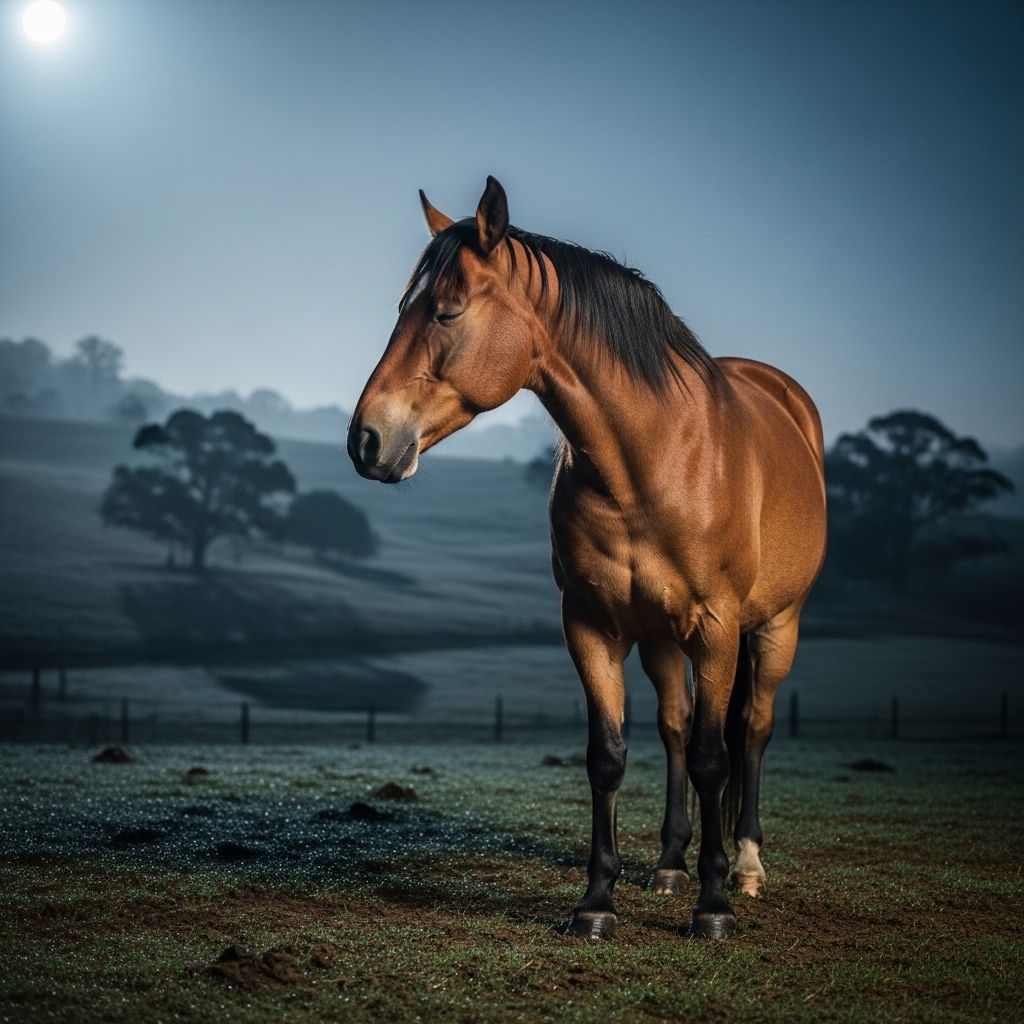Do Horses Sleep Standing Up? Understanding Equine Sleep Patterns
Unravel the mysteries of horse sleep: why and how horses rest, nap, and achieve deep sleep both standing and lying down.

Horses have fascinated humans for centuries, not just by their impressive strength and grace, but also by their unique sleeping habits. A common question among horse owners and enthusiasts is whether horses sleep standing up—and if so, why? To truly understand how and why horses rest the way they do, it’s vital to explore their anatomy, natural instincts, and patterns of sleep.
Why Do Horses Sleep Standing Up?
Unlike humans, horses have evolved as prey animals on the open plains, making them naturally cautious and tuned to their surroundings. Sleeping while standing offers these advantages:
- Quick Escape: Horses can flee rapidly in case of threats, reducing vulnerability to predators.
- Energy Conservation: A special anatomical adaptation allows horses to rest their bodies with minimal muscular effort, enabling frequent dozing throughout the day.
- Natural Herd Dynamics: In herds, some horses remain alert (standing) while others rest more deeply, providing mutual protection and balance between rest and vigilance.
The Anatomy Behind Stand-Up Sleep: The Stay Apparatus
The secret to a horse’s ability to snooze while upright lies in a system called the stay apparatus. This is a specialized arrangement of ligaments, tendons, and joints in their legs, primarily in the forelimbs, that ‘locks’ the major joints. This allows horses to support their weight without tiring their muscles, enabling them to relax and even doze without collapsing.
- With the stay apparatus engaged, horses can enter a state of light sleep while still standing up.
- This adaptation is crucial for their “asleep on their feet” behavior, especially in open environments.
Sleep Stages in Horses: Light Sleep vs. Deep Sleep
Like humans, horses experience several stages of sleep throughout a 24-hour period. However, their sleep architecture is quite different:
1. Drowsiness (Light Sleep)
Sometimes called ‘dozing,’ this state involves partial relaxation. Horses may lower their heads, partially close their eyes, and let their ears rotate or flick occasionally. During this stage, most horses remain standing and are still somewhat aware of their environment.
2. Slow-Wave Sleep (SWS)
This is a deeper, restorative phase where brain activity slows down, but horses can remain standing due to their stay apparatus. Their posture may appear especially relaxed: head mid- or low, lip drooping, eyes half-closed.
3. REM Sleep (Rapid Eye Movement)
REM sleep is the deepest stage, critical for physical and mental health. Horses must lie down—either on their chest (sternal recumbency) or on their sides (lateral recumbency)—to achieve REM sleep. In this state, their muscles need to be completely relaxed, which is not possible while standing.
Signs a Horse Is in REM Sleep
- Twitching ears, nose, or limbs
- Deep, rhythmic breathing
- Occasional snoring or body movements
How Much Sleep Do Horses Need?
On average, adult horses sleep between 2.5 and 5 hours every day. However, not all of this time is spent in one stretch. Horses take multiple short naps and periods of deeper rest throughout the day and night.
- Often, about 80% of their daily sleep occurs standing up, in the form of light or slow-wave sleep.
- For crucial REM sleep, horses need at least 30 minutes of lying down per day.
Why Must Horses Lie Down for REM Sleep?
While horses can doze and achieve light sleep while standing, REM sleep requires total muscular relaxation, which is not possible in a standing position. Lying down allows their muscles to relax completely, enabling entry into this vital sleep stage. Without adequate REM sleep, horses may suffer from sleep deprivation, which can affect behavior, performance, and overall health.
- If a horse cannot or will not lie down (due to pain, discomfort, or insecurity), REM sleep deprivation may result.
Risks and Considerations: Is It Bad if a Horse Lies Down Too Much?
While lying down for a short period is essential and healthy, excessive recumbency (more than 30-60 minutes at a stretch, or significantly more time per day) can be a sign of a medical issue, such as colic or musculoskeletal pain.
- Monitor for other signs of illness if your horse is lying down more than usual.
- Horses that are “down and can’t get up” require immediate veterinary attention.
Environmental Factors That Affect Horse Sleep
A horse’s surroundings and management have profound effects on sleep quality and patterns:
- Bedding: Horses are more likely to lie down in clean, soft, and dry bedding.
- Lighting: Turning off barn lights at night can encourage relaxation and increase time spent lying down for REM sleep.
- Security: Horses need to feel safe in their environment to comfortably lie down and sleep deeply.
- Group Dynamics: In the wild and in herds, horses often rest in turns, with some standing watch while others sleep on the ground.
Comparing Wild and Domestic Horse Sleep Habits
Wild horses, just like their domesticated counterparts, have evolved to maximize safety and survival during rest:
- Wild herds often coordinate sleeping and waking times, with adults taking turns to serve as sentries, staying partially alert while others rest.
- Feral horses tend to experience longer and more frequent periods of lying down compared to domestic horses, as social structure and safety in numbers allow greater relaxation.
| Aspect | Wild Horses | Domesticated Horses |
|---|---|---|
| Primary Sleep Position | Standing for light sleep; Lying down in groups for REM | Standing for light sleep; Lying down if feeling safe and comfortable |
| Protection | Rotate sentries for safety | Depends on environment and human care |
| REM Sleep Duration | Generally adequate, especially in stable groups | May be limited if stressed or uncomfortable |
REM Sleep Deprivation: Signs and Solutions
A horse that does not get enough REM sleep may display certain signs:
- Performance or behavioral changes (irritability, inattentiveness)
- Sudden drowsiness or collapse when standing (brief muscle weakness, called sleep collapse)
- Frequent yawning, head bobbing, or other exhaustion cues
To help your horse achieve better sleep:
- Ensure clean, comfortable bedding is available
- Minimize nightly disturbances (noise, lights, frequent activity)
- Address any pain or medical conditions with a veterinarian
- Provide turnout and allow horses to feel secure in their herd or barn group
Frequently Asked Questions (FAQs)
Q: Do horses dream during REM sleep?
A: While there is no conclusive evidence that horses “dream” exactly as humans do, they do enter REM sleep and exhibit physical signs such as twitching and movement, which are often associated with dreaming in mammals.
Q: Is it safe to wake a horse while it’s sleeping?
A: Gently waking a horse from standing rest is usually safe, but startling a horse lying down in REM sleep may cause disorientation. Approach calmly and speak softly if a wake is needed.
Q: Why do some horses rarely lie down?
A: Horses may avoid lying down due to pain (such as arthritis), inadequate bedding, or feelings of insecurity in their environment. Addressing these factors can help ensure they get necessary REM sleep.
Q: How can I tell if my horse is getting enough rest?
A: Observing your horse’s behavior, performance, and routine lying-down habits is key. A well-rested horse generally appears alert and energetic; persistent drowsiness may signal a problem.
Q: Is it normal for a horse to sleep during the day?
A: Yes, horses are polyphasic sleepers who nap in short periods both during the day and at night. Multiple brief rest intervals are perfectly normal.
Final Tips for Promoting Better Sleep in Horses
- Provide safe, clean, and spacious areas for your horse to lie down.
- Address sources of pain or discomfort with your veterinarian.
- Minimize disturbing factors, including excessive light, loud noises, and overcrowding.
- Observe your horse regularly to spot changes in sleep habits or time spent lying down.
- Encourage herd turnout if possible, as social comfort can improve sleep quality for many horses.
Understanding and respecting your horse’s unique sleep needs is an important part of equine care and contributes greatly to their lifelong health and well-being.
Read full bio of Sneha Tete












